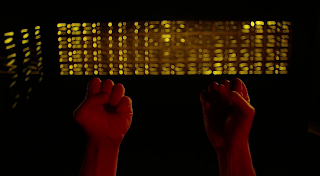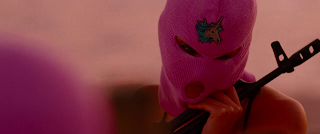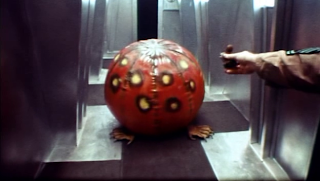Dark Star is a pretty interesting film, considering the time it was made. It came after 2001 and clearly played on the idea of ennui in space seen there, but it was also the predecessor to Star Wars and Alien in important and interesting ways. (All of the following was learned thanks to the beauty of Wikipedia). So Dark Star came out 3 years before the first Star Wars and was the first movie to show the stars rushing by as streaks in a tunnel-like way while traveling at "superliminal velocity" (warp speed, to Star Trek nerds). Its second act, in which the goofiest and perhaps least psychologically disturbed crew member fights an alien that is literally a beach ball with claws, was the inspiration for Dark Star co-screenwriter Dan O'Bannon's Alien.
The other screenwriter and director of Dark Star is John Carpenter, who is obviously much more famous for his horror film, Halloween. But this was his first film as director and you can already see here his ease and skill with using tension to draw out a story or heighten its themes. Although I've seen Escape from New York (and will someday, when I'm probably very drunk, convince myself to watch Escape from LA), I'm a little embarrassed by how many John Carpenter movies I haven't seen, which are on my list: Starman, Christine, The Thing (saw the remake, meh?), The Fog, Assault on Precinct 13, and Big Trouble in Little China (I KNOW, I'M SORRY). Might be time for a marathon. I did, however, recently watch 2010's The Ward and I can safely say that even that that movie was by and large one predictable insane asylum horror trope after another, Carpenter remains to this day extremely good at wringing the tension out of a scene.
But still, this is particularly impressive in a movie with a $60,000 budget where the supposed protagonist (who is, honestly, not even particularly likable) is fighting against a clawed beach ball and the threat of falling down an elevator shaft. This brings me to another odd detail of this film- its plot structure. So in the first sequence, we see a short video showing a US government employee of some sort send a transmission to the crew of Dark Star telling them their request for additional safety materials has been denied, although everyone on Earth is mourning for their lost captain. We learn that they've been traveling out through space for 20 years, eradicating potentially unstable planets. From Wikipedia, "The ship's crew consists of Lt. Doolittle, Sgt. Pinback, Boiler, and Talby. Commander Powell, their superior officer, was killed by a faulty rear seat panel, but remains on board the ship in a state of cryogenic suspension. The crew perform their jobs in a state of abject boredom as the tedium of their task has driven them around the bend, with only each other, an increasing number of (sometimes comical) systems malfunctions (for example, an explosion in a storage bay has destroyed the ship's entire supply of toilet paper) and the soft-spoken ship's computer for company."
So then we see Pinback goofing around until the ship tells him he must feed the beach ballien he has adopted (under the misguided idea that they need a mascot) and what follows is about 20 minutes of tense chase scene around the ship as the ballien escapes and Pinback is forced to climb around, without any safety net, inside an elevator shaft, to try and catch it. It ends bizarrely when he finally reaches freedom and retrieves the tranquilizer dart gun, which promptly pops the ballien and kills it.
Then we move onto the third part of the film in which we come to understand how truly bored and psychologically unwell each member is. One of my favorite parts of this was a reel of video diary entries that Pinback has kept, starting from the beginning of their mission, when he is trying to get someone to listen to his confession that he is not, in fact, Pinback, but a janitor who was mistaken for him at the last second and that he should not be here, to the intervening years of surly drunkenness and acceptance, to his more current suspicions that his co-workers do not, in fact, like, appreciate, or even listen to him. Supposedly Carpenter and O'Bannon consider this film to be a dark comedy which, if so, I'd say it is VERY dark indeed. The crew's general apathy leads to their eventual downfall in the final sequence, in which they prepare a bomb for a new planet they've found but then are unable to use the hyperdrive to escape its blast. Although they almost convince the bomb not to explode by teaching it Cartesian philosophy (I know I am myself but cannot be certain of any external factors), it ultimately decides if it can't trust anything then it must complete its one task. So the end, in which Doolittle, who we've learned was a surfer back home and longs to surf again, uses a piece of ship debris to surf down into the planet's atmosphere, seems to me to be another cue taken from Kubrick (Dr. Strangelove).
Anyway, I don't know why I felt compelled to explain so much of the plot except that it was sort of a different way of making a movie from what I've seen, mostly because the movie is steeped in very dark ideas about the evils of monotony and the ways in which men might lose their mind and yet there is this comical, tense, ridiculous high-wire chase sequence right in the middle of this. And also some darkly comic interactions littered throughout the other two acts.
One more thing: I saw Gravity this weekend and although a friend suggested it had a lot of references and influences from 2001, I also thought I saw a lot of Dark Star in it. Basically, if you watch sci-fi a lot and want to feel like a smarty-pants give this film a shot because after you watch it you'll start seeing its influences everywhere. It's only like an hour and change long. Totally worth it.
The infamous ballien.
Really, a surprisingly tense sequence.
Teaching the bomb philosophy.























































